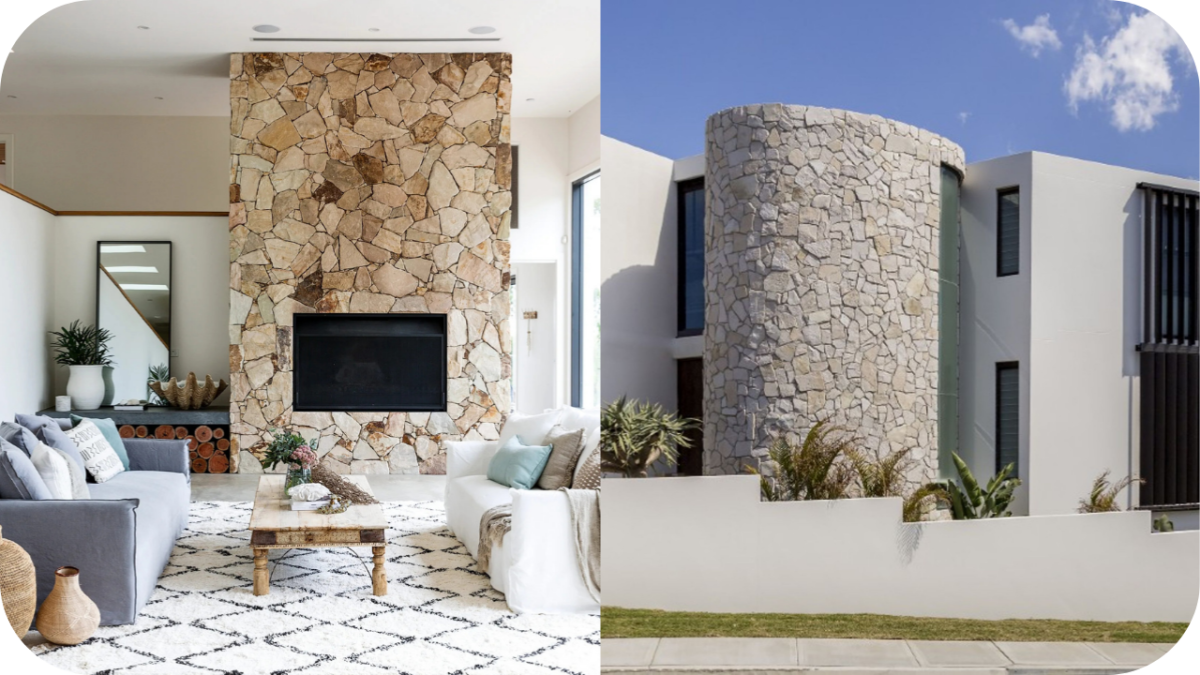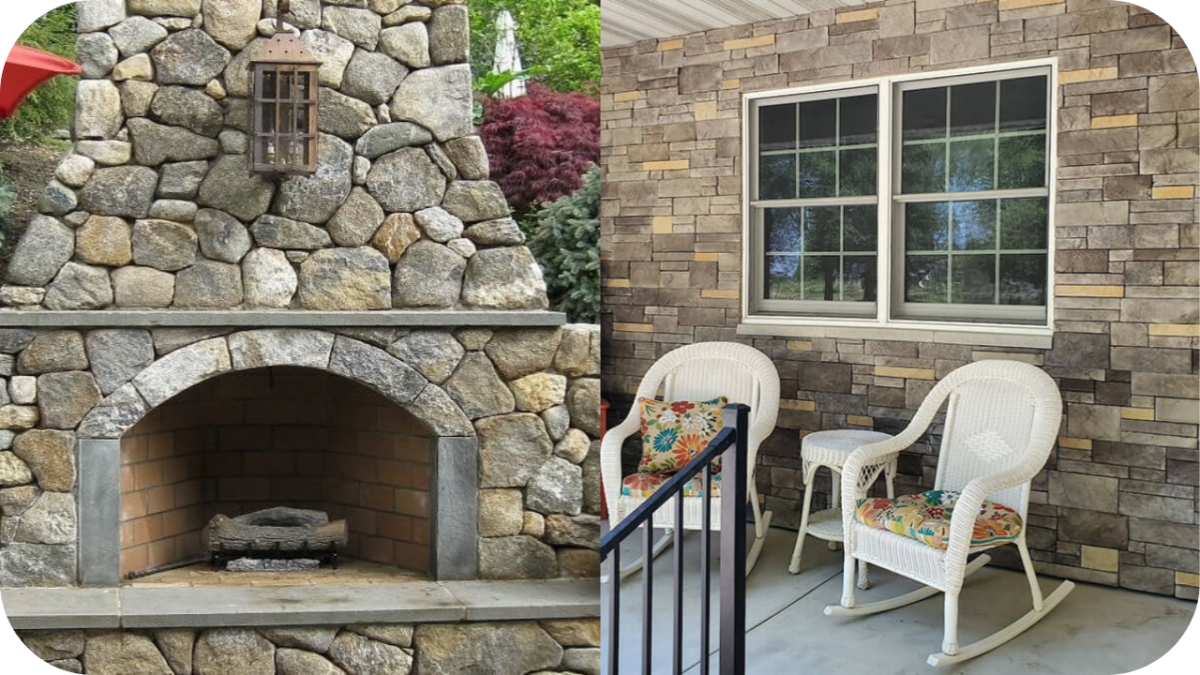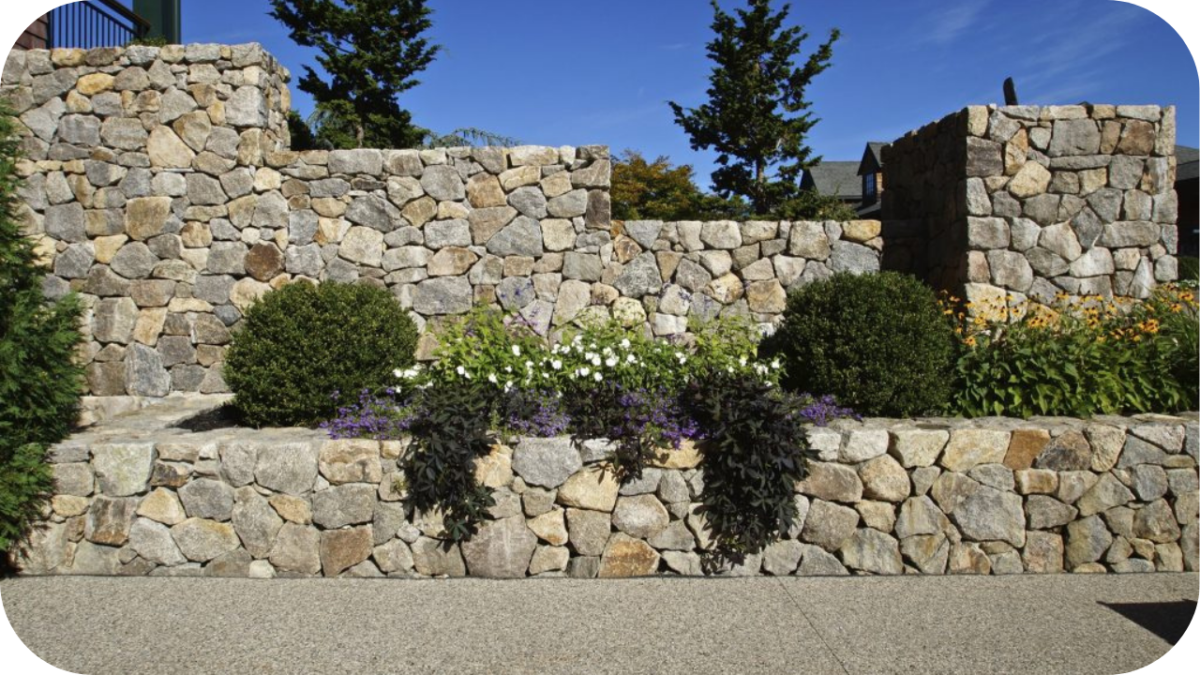Indoor vs Outdoor Stone Feature Walls: What to Know
There’s something undeniably timeless about a stone feature wall. Whether placed in a cosy living room or as a bold statement in your garden, stone adds natural character and visual interest like no other material.
But when it comes to deciding between an indoor or outdoor application, there’s more to it than just aesthetics.
In this guide, you’ll uncover the key differences, benefits, and expert tips to help you choose the right stone feature wall for your space.
What Is a Stone Feature Wall?
A stone feature wall is a design element that uses natural or engineered stone to create a striking focal point within a space. Unlike standard painted or plastered walls, these are meant to draw attention, add texture, and elevate the overall aesthetic of your home or outdoor area.
From rustic charm to sleek modernism, stone feature walls can be tailored to suit any design style. Homeowners often choose materials like slate, limestone, travertine, or granite—each offering its own unique tones, finishes, and structural qualities.
Beyond looks, these walls serve practical purposes too. Indoors, they may act as thermal mass for improved insulation, especially when placed behind a fireplace. Outdoors, they can provide privacy, define garden zones, or enhance kerb appeal with architectural depth.
Whether you’re enhancing your interior décor or upgrading your landscaping, a stone feature wall offers timeless appeal and lasting value.
Key Differences Between Indoor and Outdoor Stone Feature Walls
Choosing between an indoor and outdoor stone feature wall involves more than just location. Each setting demands different materials, maintenance levels, and design approaches.
Material Selection Varies Greatly
Indoor stone walls typically feature smoother, decorative stones such as marble, travertine, or sandstone. These stones are chosen for their colour variation, polished finishes, and ability to blend seamlessly into interior décor.
Outdoor walls require stronger, more resilient stones like granite, bluestone, or quartzite—materials that can endure extreme weather conditions without cracking, fading, or eroding. The choice of stone depends heavily on whether the priority is beauty or durability.
Environmental Exposure and Weather Resistance
Outdoor feature walls face harsh environmental elements—UV rays, heavy rain, frost, and temperature swings. These factors demand proper sealing, drainage, and installation techniques.
Indoors, stone walls remain protected from weather, so there’s less risk of damage. This controlled environment allows a wider range of materials and finishes to be used, including more delicate or porous stones that wouldn’t survive outside.
Installation Requirements and Structural Support
Outdoor stone installations require deeper foundations or structural reinforcement due to exposure to wind, soil movement, or external pressure. For example, a retaining wall in a garden needs drainage and stability to avoid shifting.
Indoors, installation is often simpler, as walls are affixed to existing internal structures with fewer environmental risks to account for. However, weight still matters—particularly with full-stone panels—so professional installation is recommended in both cases.
Design Flexibility vs Functional Constraints
Indoors, design is driven by aesthetics. Homeowners can play with lighting, textures, and colour palettes to create luxurious or rustic looks. Outdoor stone walls, however, must balance beauty with function.
They’re often used for privacy, pool surrounds, or garden zoning, where practicality can limit design options. Water drainage and non-porous finishes may all influence your choice of materials and layout.
Maintenance and Longevity Considerations
Exterior stone walls typically need more upkeep. Regular cleaning, resealing, and inspection for cracks or moss build-up are essential for preserving appearance and integrity.
Indoor walls are easier to maintain, mainly requiring light dusting or wiping with stone-safe products. That said, both types of feature walls benefit from periodic sealing to maintain colour vibrancy and structural strength over time.
Best Stone Options for Indoor Feature Walls
Looking to elevate your interiors with natural charm? The right stone can transform an ordinary wall into a timeless centrepiece—here are the top picks we trust at Splendour in Stone.
Marble
At Splendour in Stone, homeowners often gravitate towards marble to create an elegant interior statement. Its striking veining and smooth finish bring undeniable sophistication to spaces like entrance halls, fireplaces, and living rooms.
Whether you’re after timeless white or dramatic black, marble offers design versatility with a premium finish. While porous by nature, it performs beautifully indoors with proper sealing and is remarkably low-maintenance in a controlled environment.
Travertine
Travertine remains a favourite among our clients for its soft, earthy tones and naturally textured finish. It’s ideal for lounges, hallway features, or creating a spa-like ambience in bathrooms.
Its subtle movement and colour variations lend a relaxed, organic look that works across many design styles. When sealed correctly, travertine stays resilient and easy to maintain, requiring just a gentle clean and a keen eye for preserving its natural beauty.
Sandstone
Few materials offer the rugged beauty and character of sandstone. At Splendour in Stone, we recommend it for homeowners seeking a warm, tactile feature that brings nature indoors. Its texture and variation—from soft creams to golden browns—suit both rustic and contemporary interiors.
Sandstone works particularly well behind fireplaces or as a bold living room centrepiece. Being more porous, we always advise sealing it on installation to ensure long-term durability and stain resistance.
Limestone
Limestone delivers quiet sophistication to modern interiors. Its subtle tones—ranging from soft whites to greys—make it perfect for open-plan settings, feature nooks, and wall cladding that doesn’t dominate the space.
At Splendour in Stone, our limestone collections are chosen for their consistency, natural texture, and long-lasting appeal. While it’s a softer stone, it stands the test of time with proper care and regular sealing, particularly in low-traffic, decorative areas.
Best Stone Options for Outdoor Feature Walls
Want a wall that weathers it all? The right stone doesn’t just elevate your outdoor space—it endures it. Let’s look at the top contenders built to handle Australia’s climate with style.
Bluestone
Bluestone continues to be one of our most requested outdoor stones—and for good reason. It’s incredibly hardwearing, naturally slip-resistant, and adapts well to Melbourne’s changing climate.
At Splendour in Stone, we supply premium bluestone that delivers both form and function. Its cool grey tones and subtle catspaw textures add visual interest to garden walls, pool surrounds, and façades. When sealed correctly, it resists weathering and maintains its beauty with minimal effort.
Granite
If durability is your top priority, granite is the clear standout. Our granite range offers exceptional density and resilience, making it ideal for exposed areas like boundary walls, outdoor kitchens, or built-in barbecues.
Its crystalline structure adds depth, while the colour range—from greys to charcoal—complements a variety of landscapes. While granite may be dense, its elegant finish makes it as suitable for prestige properties as it is for functional builds.
Quartzite
Quartzite brings a distinct touch of sophistication to outdoor feature walls. At Splendour in Stone, we love its layered texture and mineral sheen, which adds a refined look without compromising toughness.
More durable than many other natural stones, quartzite is perfect for areas exposed to sun, rain, and wind. From accent garden walls to dramatic entry façades, it makes a lasting impression and effortlessly withstands Australia’s climate.
Slate
Slate offers understated elegance with exceptional resilience for those seeking texture and tonal variation. Our carefully sourced slate options lend themselves beautifully to retaining walls, alfresco areas, and feature garden spaces.
It’s naturally resistant to moisture and UV rays, and its layered surface brings movement and shadow play throughout the day. With proper installation and sealing, slate requires very little upkeep—making it a smart choice for outdoor use.
Indoor vs Outdoor Stone Wall Maintenance
Think all stone walls are equal when it comes to care? The reality is—indoor and outdoor walls face completely different challenges.
Indoor Walls
Thanks to their protected environment, indoor stone feature walls are generally low-maintenance. We recommend routine dusting with a soft cloth or microfibre duster at Splendour in Stone to prevent surface build-up.
For deeper cleans, a damp cloth with a pH-neutral cleaner works best—never harsh chemicals. Sealing is still important, especially with porous stones like sandstone or limestone, as it helps prevent stains and preserves colour richness.
With the right care, your indoor feature wall can retain its natural beauty for decades.
Outdoor Walls
Outdoor stone walls require a more hands-on approach due to exposure to sun, rain, frost, and pollution. We advise applying a premium-grade penetrating sealer to protect against moisture and discolouration.
Occasional pressure washing on a low setting can remove surface grime or moss, but always use a stone-safe detergent.
At Splendour in Stone, we also guide clients on choosing the right jointing and drainage solutions to prevent long-term damage caused by water pooling or freeze-thaw cycles.
Cost Comparison: Indoor vs Outdoor Feature Walls
Budgeting for beauty? While both indoor and outdoor stone walls elevate a space, the associated costs can vary significantly depending on material, installation complexity, and maintenance requirements. Here’s a quick breakdown to help guide your decision:
| Cost Factor | Indoor Stone Feature Walls | Outdoor Stone Feature Walls |
| Material Cost | Lower to mid-range depending on stone type | Often higher due to need for weather-resistant materials |
| Installation Complexity | Easier (fixed to existing wall structures) | More complex (may need foundations or structural support) |
| Sealing & Protection | Optional for some stones | Essential for all outdoor applications |
| Maintenance | Minimal (mainly dusting and occasional wipe-down) | Moderate to high (cleaning, resealing, moss control) |
| Labour Costs | Generally lower due to simpler access and tools | Higher due to outdoor conditions and prep work |
| Long-Term Durability | High with minimal upkeep | High if properly sealed and maintained |
Pro tip from Splendour in Stone: Investing slightly more upfront in durable stone and expert installation ensures both types of walls stand the test of time—indoors or out.
Which One Is Right for Your Space?
Where stone make the biggest impact? Choosing between an indoor and outdoor stone feature wall ultimately depends on your space, purpose, and personal style.
Start by considering where you want the visual focus. If you’re looking to elevate your living room, entryway, or fireplace, an indoor stone wall adds texture and elegance without needing to brave the elements. These walls create a calm, curated environment with minimal maintenance.
For outdoor spaces, think functionality as well as form. Do you need privacy in the garden, a striking façade, or a durable backdrop for an alfresco area? Then an outdoor stone wall is your go-to. With the right sealing and stone choice—something we help our clients with daily at Splendour in Stone—your wall can stand up to Australia’s conditions while enhancing the landscape.
Still unsure? Match your indoor and outdoor styles with the same stone type to create a seamless flow between both zones.
Conclusion
Whether you’re transforming your interior or enhancing your outdoor living, a stone feature wall adds lasting beauty and value. At Splendour in Stone, we offer expert advice and premium natural stone to suit any setting. Need help choosing the perfect fit for your space? Get in touch—we’ll guide you every step of the way.





